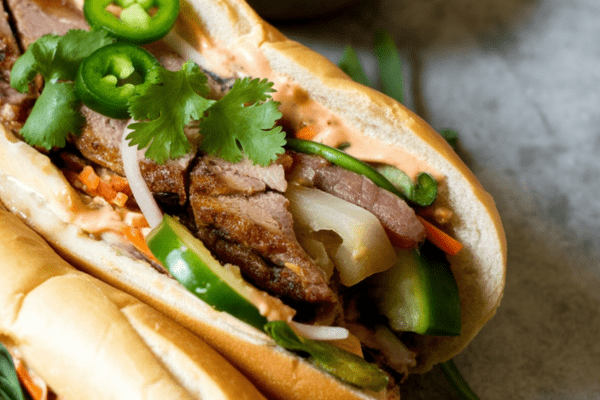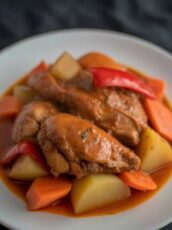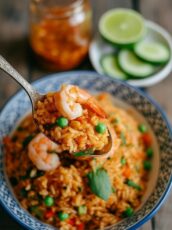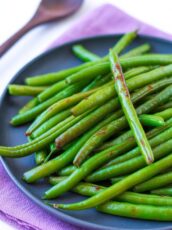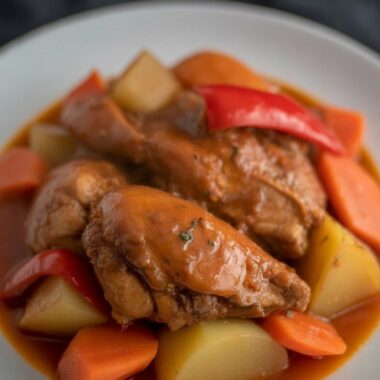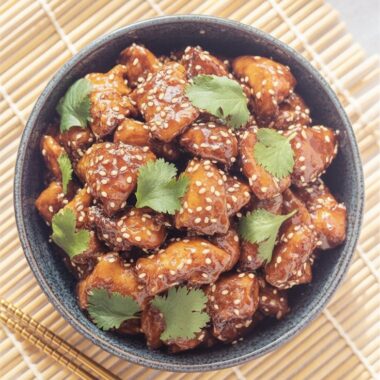If you love those old-school Chinese bakery almond cookies—the ones with the shiny tops, crackly edges, and rich almond aroma—you’re in for a treat. This recipe has been my go-to for gatherings, tea times, and frankly, just for stashing in a cookie jar for those late-night cravings.
They’re lightly sweet, crumbly without falling apart in your hand, and deliver that toasty almond punch that makes them so nostalgic.

I’m excited to share my updated version with you. It’s taken a few rounds of tweaking (okay, more than a few) to get it right, but I think this one hits all the marks.
A Need for Recipe Re-Testing
I’ll be honest—I’ve had a love-hate relationship with these cookies over the years. My first attempts always got compliments on the classic look but… there was something off. Too much leavening made them taste metallic, or they’d spread too much and lose their shape.
So I rolled up my sleeves (and bribed my family with promises of free cookies) and got to testing again. I wanted them to taste like the ones I remember getting in little pink bakery boxes in Chinatown growing up—simple, not too sweet, with a satisfying crunch.
If you’ve tried making these before and weren’t thrilled, I hope you’ll give this version another shot. It’s much better balanced and a little more forgiving.
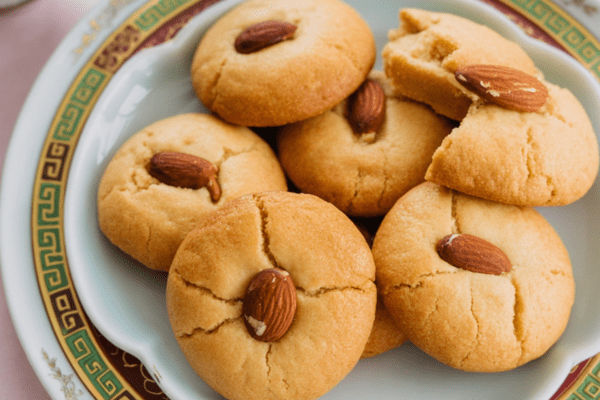
How Our Old Recipe Held Up to Others
You know how some recipes sort of haunt you if they don’t work quite right? That’s what happened here. I’d shelved the old recipe for a while, telling myself I’d get back to it when I had time.
Eventually, I sat down with notes from friends who tried it, and feedback from cookie swaps. Some loved the texture but felt the flavor was flat or had weird aftertastes. I even read comments saying the old version had too much of that “baking soda” tang.
One thing I did appreciate was that people wanted to love it. There’s something so familiar and comforting about these cookies, and I didn’t want to let them down.
So I started reading other versions, baking side-by-side tests, and doing what I do best—making a big mess in the kitchen.
What Are the Characteristics of a Chinese Almond Cookie?
If you’ve ever bought these at a Chinese bakery, you know exactly what I mean. They’re a little old-fashioned in the best way.
You bite in and they’re crisp, but not hard. The inside crumbles gently but doesn’t disintegrate. They’re lightly sweet—just enough to satisfy without feeling like a sugar bomb.
The tops are shiny and golden from an egg wash. They often have that one whole almond pressed in the center, slightly toasted during baking. I used to fight my sister for the ones with the biggest almonds.
Over the years, some bakeries have changed their recipes to make them softer or sweeter, but I always crave that classic bakery style that’s closer to shortbread than a chewy cookie.

What We Changed & Why
Here’s the real kitchen talk about why this new version works better.
Lard and Butter Mix:
I stuck with lard—it’s traditional and gives that unmistakable crumbly texture. But I added butter to smooth out the flavor. Using only lard sometimes made them taste…well, porky. Not exactly what you want in a cookie. The blend gives the best of both worlds: classic texture with a cleaner, richer taste.
Reduced Leavening:
I learned my lesson here. Too much baking soda or powder is the enemy. I cut them way back. You still get a slight lift, but they don’t puff and crack like crazy or taste metallic.
Bigger Cookies:
The new version makes about 15 bigger cookies. I like them this way—they look bakery-style and hold an almond in the center perfectly.
Boosted Almond Flavor:
Almond extract alone wasn’t enough. I added almond flour (toasted for extra depth). That step makes such a difference. You can smell the almonds as they toast in the pan—it’s that warm, nutty smell that tells you you’re on the right track.
Granulated Sugar:
I ditched powdered sugar because I hate sifting. Granulated sugar mixes in easily and gives a subtle crunch. The cookies are a little sweeter than before, which I think helps balance the nutty, savory edge.
Egg Yolk for Richness:
Kept this from the old version. It makes the dough easier to handle and gives a richer bite.
Added Salt:
This was my big facepalm moment with the old recipe. Of course they tasted flat—we forgot the salt! Adding just a bit made all the other flavors pop.
Egg Wash with Whole Egg:
I use a whole beaten egg now for the tops instead of just yolk. It’s less eggy and gives that perfect shine over the almond.
Chinese Almond Cookies

There’s something undeniably comforting about old-school cookies—the kind that instantly transport you back to childhood visits, festive gatherings, or a tin of treats gifted during the holidays.
Ingredients
- ½ cup almond flour
- ⅔ cup granulated sugar
- 1¼ cups all-purpose flour
- ½ teaspoon baking soda
- ⅛ teaspoon baking powder
- ¼ teaspoon salt
- 1 egg yolk
- ¼ cup melted lard
- 1¼ teaspoons almond extract
- 5 tablespoons salted butter, softened
- 15 whole almonds
- 1 egg, beaten (for egg wash)
Instructions
- 1Preheat & PrepStart by positioning a rack in the center of your oven and preheating it to 350°F (175°C). Line a baking sheet with parchment paper so you're ready to go.
- Toast the Almond FlourIn a dry skillet over medium heat, gently toast the almond flour. Stir it constantly—it should deepen just one shade in color and release a lovely nutty aroma. This step adds an extra layer of flavor that’s worth the few extra minutes.
- Mix the Dry IngredientsIn a large bowl, whisk together the toasted almond flour, sugar, all-purpose flour, baking soda, baking powder, and salt. Quick tip: accurate measuring is crucial here. If the flour is packed too tightly, your dough might turn out dry. If that happens, don’t worry—a tablespoon or two of water will bring it back together.
- Make the DoughIn a small bowl, whisk the egg yolk with melted lard and almond extract. Add this mixture, along with the softened butter, to the dry ingredients. Mix everything together—your hands work best here—until it forms a soft, pliable dough.
- Shape the CookiesScoop out pieces of dough and roll them into balls about the size of a ping-pong ball. Gently flatten each into a disc and place on your prepared baking sheet, spacing them about 2 inches apart. Press one whole almond into the center of each cookie. If small cracks appear around the edges, it’s perfectly fine—just smooth out any larger ones.
- Brush & BakeLightly brush the tops of the cookies with beaten egg. Bake for 13–15 minutes, or until the edges are lightly golden. Let the cookies cool completely before digging in—they firm up beautifully and develop that signature crunch as they cool.
Nutrition Information:
Yield: 15 Serving Size: 1Amount Per Serving: Calories: 176Total Fat: 11gSaturated Fat: 4gTrans Fat: 0gUnsaturated Fat: 6gCholesterol: 38mgSodium: 124mgCarbohydrates: 18gFiber: 1gSugar: 9gProtein: 3g
Asianplated.com, occasionally offers nutritional information for recipes contained on this site. This information is provided as a courtesy and is an estimate only. This information comes from online calculators. Although allchickenrecipes.com attempts to provide accurate nutritional information, these figures are only estimates.
Chinese Almond Cookies Recipe Instructions
Now let’s talk about actually making them. If you’ve never baked with lard before, don’t let it scare you—it behaves a lot like shortening or butter.
Preheat Your Oven:
350°F is the sweet spot. I like to get the oven fully hot before I even start mixing the dough.
Toast the Almond Flour:
This is my favorite part. Stir it in a dry pan over medium heat until it smells warm and nutty and turns just a shade darker. Don’t walk away—almond flour can burn quickly.
Mix Dry Ingredients:
Whisk the toasted almond flour with sugar, all-purpose flour, baking soda, baking powder, and salt. Measure carefully—too much flour can make the dough crumbly. If it feels too dry, I just add a splash of water until it comes together.
Combine Wet Ingredients:
Whisk the egg yolk with melted lard and almond extract. Add this, plus softened butter, to the dry ingredients. I use my hands or a sturdy spatula to bring it together. Don’t overmix—just enough to get a cohesive dough.
Shape the Cookies:
Roll into ping-pong-sized balls and flatten into discs. Press an almond into the center of each one. They might crack a bit around the edges—that’s normal and charming. I usually push any big cracks back together with my fingers.
Egg Wash:
Brush them generously with beaten egg. It gives that bakery shine and helps the almond toast up nicely.
Bake:
About 13–15 minutes until they’re golden on top and smell amazing. I let them cool completely before eating—though I admit I always sneak one warm.
These cookies make the house smell so good you’ll want to bake them just for that. They’re perfect with a cup of tea in the afternoon or tucked into a cookie tin for sharing.
Try other recipes:


